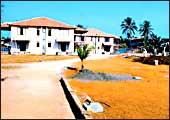 |
| Sun, sand and sea: There is
plenty of the three but not enough land. And with 3.98 lakh
migrants and an ever increasing number of tourists, Goa is
on a boil |
As
the sun sets on the golden sands of Baga beach on North Goa's
bustling beach belt, business in the shacks, nightclubs and restaurants
warms up. One such small but popular European restaurant is managed
by a British couple, Karolyn and Leonard. As Karolyn personally
chats up with the guests, her husband doubles up as the chef.
Originally from Leicester in the UK, the couple's love for sunshine,
coupled with weariness with "the rat race back home",
compelled them to sell their hairdressing business and move abroad.
"We managed a restaurant in Greece for some time. Then, a
friend asked us if we would like to manage a restaurant in Goa.
And here we are!" says Karolyn who has been in Goa since
last October. Karolyn and Leonard have valid business visas. Unlike
James Christiansen (name changed).
A UK passport holder, Christiansen has been spending
six months a year in Goa for nearly three years in a row. An ex-serviceman
with the British army, Christiansen 'co-owns' a small cottage
on the Anjuna beach stretch. "I get a disability pension
and with that I live a better life in Goa than I would in Durham
where I come from," says Christiansen between swigs of beer.
He rents out his two-room cottage to other tourists and makes
enough to afford "a day away in Bali". The only problem?
Christiansen doesn't have a valid visa to do business. He isn't
the only one running businesses illegally. "Some 300-plus
cases of foreigners owning land have been detected. Wherever there
is a problem with illegal ownership, we will refer the cases to
the Reserve Bank of India," says Goa State Chief Secretary
J.P. Singh.
It's not just languorous Englishmen who are angling
for a piece of paradise. Almost everybody, right from the loaded
Indian middle class to greedy politicians, is eyeing a piece of
the sun-baked soil. Unfortunately, there just isn't enough of
it to go around in this tiny state. Inevitably that's leading
to corruption (illegal constructions are a dime a dozen), friction
(between enthusiastic ministers and belligerent activists) and
the fear that Goa will soon resemble a concrete jungle, thereby
eroding the state's unique selling proposition itself.
| Plan of Mass
Destruction? |
| All you wanted to know about recently scrapped
Regional Plan 2011.
|
| What's a regional plan? |
| It is a decennial study done by the Town and
Country Planning Department of the Goa government that maps
trends in population, economy and changes in topography of
the region. Usually a land use survey is conducted and then
a policy is chalked out in conjunction with local bodies like
municipalities for the next decade for economic development
and use of land. Goa's first regional plan was drafted in
1981 and notified in 1982, and approved by the government
in 1985. In short, the regional plan is like a blueprint for
regional development-a plan that rolls out land use and development
strategy for the future. |
| What's Regional Plan 2011? |
| In 1998, the government started working on
draft version for a regional plan for the state till 2011.
The draft was prepared over a period of three years and circulated
at technical conventions organised by the town planning department.
It went through several changes between 2000 and 2003. Finally,
a draft version of the plan was 'made public' for comments
in November 2005 and notified in August 2006. |
| What's the problem? |
| Activists allege that the plan would convert
Goa into a concrete jungle and deplete its natural resources.
There are also allegations that the government has doctored
the plan to suit the needs of the builders and construction
lobby. The government has also been accused of opening up
agricultural, forest and areas close to beaches (in violation
of CRZ norms) to convert them into settlement land for construction.
These changes, according to the Save Goa movement, might lead
to "increase in migrant population along with the accompanying
social problems like increased crime". Another bone of
contention has been the fact that the government bypassed
local bodies like gram panchayats while planning, thereby
contravening the directives of the 73rd and 74th amendments
to the Constitution of India. In addition, there are also
allegations that the subsequent drafts of the regional plan
constantly increased the quantum of settlement land in a clandestine
manner. Observers have alleged that the draft of the Regional
Plan 2011 initially provisioned for 36,994 hectares. The final
plan, which was notified a couple of months later, provisioned
for 45,901 hectares-a 21 per cent jump in less than a year.
|
| What's happened? |
| In the aftermath of protests from across the
state, Goa's Minister for Town & Country Planning Atanasio
'Babush' Monserrate quit the state cabinet earlier this month.
The regional plan has been denotified, with retrospective
effect. |
Land, Land Everywhere...
 |
"Every environmental law is being
violated with scant respect by the politicians, to cater to
the builder lobby"
Oscar Felipe Pinto Rebello/Save Goa activist |
During the day, it's a cool 25 degrees centigrade
in the shade. But Goa, itself, is on the boil. Not a single day
passes by without a morcha being taken out, or public interest litigation
filed in the court. Tourists-Indian and foreign-crib about the exorbitant
hotel rooms and haggle angrily with cabbies. The cabbies are, in
turn, angry with tour coach operators for eating into their business.
The environmentalists are seeing red because of the vanishing greenery.
Almost everybody in this picturesque state with sun-baked sands
is fuming, for one reason or the other-except of course, the immaculately
stoned (but that's another story).
But if you sit inside Dr
Oscar Felipe Pinto Rebello's cool, one-room clinic in Panaji,
it's tough to imagine what the strife is all about. "As a
doctor, I think there is an invasion on what we Goans call as
Sussegado-our laidback attitude," muses 39-year-old Rebello,
who sports a 'Livestrong' style wrist-band which has the words
'Save Goa' emblazoned on it. A self-confessed 'first time protestor',
he has been the convener of the high decibel Save Goa campaign
over the last couple of months. What goaded this physician to
reach out for the flag and microphone is something called the
Regional Plan 2011 (see Plan of Mass Destruction?). In fact, this
plan has raised the hackles of citizenry in the sleepy villages
of Goa. The bone of contention is the surface utilisation portion
of the regional plan, which deals with Goa's most precious asset-land.
 |
| Karolyn (R) came to Goa to escape the rat race
back home. She runs a restaurant on Baga beach. While she
has a valid business visa, there are many without one. Some
300 cases of foreigners owning land have been detected |
Only 2.9 per cent of Goa's land is settlement land,
where people can stay and construction is permitted. The rest of
the land is covered by forests, agricultural land, mines, and plantations
where construction is not allowed. In addition, Goa has a coastal
line of about 105 km and as per coastal regulation zone (CRZ) laws,
construction is not allowed within a distance of 500 metres from
where high tide waters kiss the shores. That effectively takes away
another 52 sq. km. As Nitin Kunkolienker, President, Goa Chamber
of Commerce and Industry (GCCI), says: "More than 85 per cent
of land in Goa is undevelopable. For Goa to develop and grow, we
need more land for settlement."
Among other things, the Regional
Plan 2011 proposed to free up around 6,802 hectares of land. The
land up for conversion included 1,847 hectares of cultivated
land, 1,153 hectares of natural cover, 960 hectares of social
forest, 22 hectares of mangroves and 75 hectares of an export
promotion zone. It was this apparent intrusion that spurred Robello
to spearhead the Save Goa movement. "With that regional plan,
the government would have killed the greenery in Goa and turned
it into a concrete jungle. There is no respect for law of the
land. Every environmental law, CRZ rule is being violated with
scant respect by the politicians, to cater to the builder and
construction lobby," says Rebello.
 |
| Not picture perfect: The scarcity of land has
put real estate prices out of the reach of middle class Goans
|
Activists also accuse the government of keeping
local bodies like Gram Panchayats in the dark while drawing up such
plans. And there is some truth in these allegations. Documents available
with BT show that despite repeated requests for copies of the regional
plan from the Calangute Panchayat village over a period of four
years, not many details were provided. Calangute has a population
of approximately 15,000 people and has beach stretches which are
popular among foreign tourists. Says Calangute village Sarpanch
Joseph Sequeira: "The regional plan would have been a terrible
disaster for my village. The planners wanted to build on one of
the most beautiful cliffs in Goa, which attracts lakhs of tourists."
Last fortnight, the government scrapped the regional plan because
of widespread opposition to the plan. But is dust-binning the
plan the best that could have done? Fact is that there is a shortage
of land, to which a solution needs to be found. The regional plan
was ridiculous but it could have been salvaged instead of being
shredded. The shortage of land has ironically been exacerbated by
one of Goa's greatest success stories-tourism, which has not only
drawn in lakhs of foreign tourists but also migrant labourers from
across the country. "About 35 per cent of the population is
migrants today. About a decade ago, the immigrant population was
one-and-a-half lakh, today it's doubled almost to 3.98 lakh,"
says Kunkolienker. This influx of immigrants, who compete with the
local populace for jobs and living space, is increasingly becoming
a source of tension.
 |
"Wherever there is a problem with
illegal ownership, we will refer the cases to RBI"
J.P. Singh, Goa State Chief Secretary |
To top it off, the scarcity of land has created
a real estate boom. A square metre in capital Panaji costs as much
as Rs 30,000, while in Calangute, a square metre can cost a little
over Rs 22,000. With rates like these, buying land is becoming unfeasible
for the middle class Goan. "Today, Goa has 270,000 houses for
a population of 14 lakh people, which will increase to 18 lakh in
10 years. We need 4.5 more lakh houses by 2015. Where are they going
to come from?" asks Kunkolienker. "The common Goan is
hardly able to buy any property. As a result, the people who are
buying land in Goa are nris, real estate developers and rich non-Goans,"
he adds. Kunkolienker also believes that unless the government opens
up more land, industries in Goa are likely to suffer.
Killing the Golden Goose
 |
"More than 85 per cent of land
in Goa is undevelopable. We need more land for settlement"
Nitin Kunkolienker, President, Goa Chamber of Commerce and
Industry |
What's even more foreboding is the fact that
hotel room rates have almost doubled, if not tripled, in Goa over
the past five years. And that's affecting Goa's USP as a low-cost
tourist destination. Currently, according to government estimates,
there is a shortage of 5,000 hotel rooms in Goa and that's driving
up room tariffs. "Today, a four or five-star hotel room in
Goa is as costly, if not costlier, than a room in most South East
Asian holiday destinations like Bangkok and Singapore. That's starting
to drive away tourists from Goa," says a hotelier, who runs
a three-star hotel in South Goa. Some 35 per cent of the state's
revenues come from tourism and allied services.
At the time of writing, despite being mid-season, most shacks
that dot the North Goa coastline were deserted. Many shut down
as early as 10:30 p.m. on weekdays. Even government officials
concede that tourism has been hit this year. "Because of
the terrorist attack warning by Israel, there has been a slight
drop in tourism. Even the hotel industry has reported some cancellations,"
says Singh. The state government, for some time now, has been
trying to attract the more affluent kind of tourist
instead of the backpacker variety. But that's
easier said than done. Hoteliers feel that Goa lacks basic infrastructure
needed to graduate into a high-end tourist centre. A walk into Goa's
ramshackle, congested Dambolim airport is proof enough. "We
will not be able to pitch for a top class international medical
conference in Goa without something as basic as a convention centre,"
says Ananya Sinha, Director (Sales), Taj Exotica. And be it
carving out a golf course or building a convention centre, its back
to the same old question- where will the land come from? The Regional
Plan 2011 tried to offer a solution, albeit a flawed one. With the
scrapping of the plan, it's back to square one. Activists with the
Save Goa movement point out that they are not against non-Goans
or development. But neither do they have solutions to offer for
the future. With state legislative elections scheduled for May,
not much is going to happen in the state other than political hyperbole
and a lot more rancour. The development agenda in Goa, for the time
being, at least, is like the visiting tourist-on its back and half
asleep.
|










